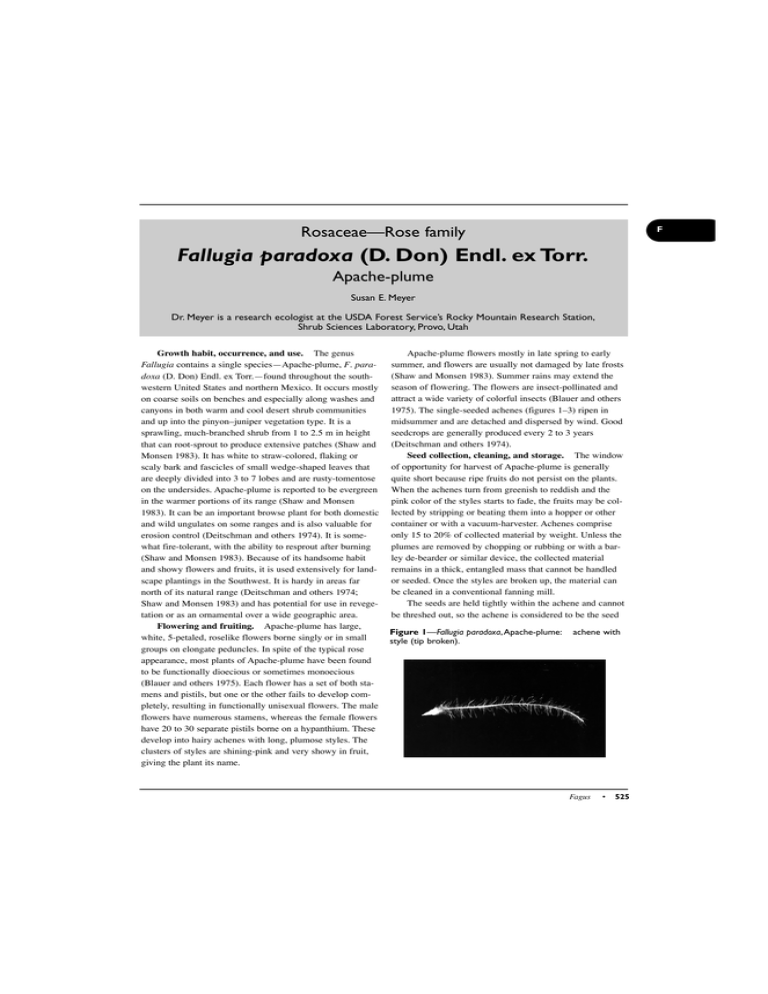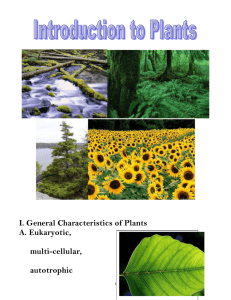Fallugia paradoxa Rosaceae—Rose family Apache-plume
advertisement

F Rosaceae—Rose family Fallugia paradoxa (D. Don) Endl. ex Torr. Apache-plume Susan E. Meyer Dr. Meyer is a research ecologist at the USDA Forest Service’s Rocky Mountain Research Station, Shrub Sciences Laboratory, Provo, Utah Growth habit, occurrence, and use. The genus Fallugia contains a single species—Apache-plume, F. paradoxa (D. Don) Endl. ex Torr.—found throughout the southwestern United States and northern Mexico. It occurs mostly on coarse soils on benches and especially along washes and canyons in both warm and cool desert shrub communities and up into the pinyon–juniper vegetation type. It is a sprawling, much-branched shrub from 1 to 2.5 m in height that can root-sprout to produce extensive patches (Shaw and Monsen 1983). It has white to straw-colored, flaking or scaly bark and fascicles of small wedge-shaped leaves that are deeply divided into 3 to 7 lobes and are rusty-tomentose on the undersides. Apache-plume is reported to be evergreen in the warmer portions of its range (Shaw and Monsen 1983). It can be an important browse plant for both domestic and wild ungulates on some ranges and is also valuable for erosion control (Deitschman and others 1974). It is somewhat fire-tolerant, with the ability to resprout after burning (Shaw and Monsen 1983). Because of its handsome habit and showy flowers and fruits, it is used extensively for landscape plantings in the Southwest. It is hardy in areas far north of its natural range (Deitschman and others 1974; Shaw and Monsen 1983) and has potential for use in revegetation or as an ornamental over a wide geographic area. Flowering and fruiting. Apache-plume has large, white, 5-petaled, roselike flowers borne singly or in small groups on elongate peduncles. In spite of the typical rose appearance, most plants of Apache-plume have been found to be functionally dioecious or sometimes monoecious (Blauer and others 1975). Each flower has a set of both stamens and pistils, but one or the other fails to develop completely, resulting in functionally unisexual flowers. The male flowers have numerous stamens, whereas the female flowers have 20 to 30 separate pistils borne on a hypanthium. These develop into hairy achenes with long, plumose styles. The clusters of styles are shining-pink and very showy in fruit, giving the plant its name. Apache-plume flowers mostly in late spring to early summer, and flowers are usually not damaged by late frosts (Shaw and Monsen 1983). Summer rains may extend the season of flowering. The flowers are insect-pollinated and attract a wide variety of colorful insects (Blauer and others 1975). The single-seeded achenes (figures 1–3) ripen in midsummer and are detached and dispersed by wind. Good seedcrops are generally produced every 2 to 3 years (Deitschman and others 1974). Seed collection, cleaning, and storage. The window of opportunity for harvest of Apache-plume is generally quite short because ripe fruits do not persist on the plants. When the achenes turn from greenish to reddish and the pink color of the styles starts to fade, the fruits may be collected by stripping or beating them into a hopper or other container or with a vacuum-harvester. Achenes comprise only 15 to 20% of collected material by weight. Unless the plumes are removed by chopping or rubbing or with a barley de-bearder or similar device, the collected material remains in a thick, entangled mass that cannot be handled or seeded. Once the styles are broken up, the material can be cleaned in a conventional fanning mill. The seeds are held tightly within the achene and cannot be threshed out, so the achene is considered to be the seed Figure 1—Fallugia paradoxa, Apache-plume: style (tip broken). achene with Fagus • 525 F Figure 2—Fallugia paradoxa, Apache-plume: style removed. achene with Figure 3—Fallugia paradoxa, Apache-plume: section through an achene. longitudinal unit. Reported weights are 925 to 1,280 achenes/g (420,000 to 580,000/lb) (Deitschman and others 1974; Belcher 1985; Link 1993). Fill is sometimes quite low—for example, Link (1993) reported 30 to 40%—and unfilled fruits cannot be detected or removed in cleaning; it is therefore a good practice to check fill in the field before harvest. Seeds of Apache-plume apparently are orthodox in storage behavior, but they have a more limited shelf life in warehouse storage than those of related genera. Serious loss of viability commences after as little as 3 years, even if seeds are held at optimum moisture content (7 to 12%) (Belcher 1985; Deitschman and others 1974; Link 1993). 526 • Woody Plant Seed Manual Germination and seed testing. Most workers report that seeds of Apache-plume germinate readily without pretreatment, at least when freshly harvested (Belcher 1985; Deitschman and others 1974; Link 1993; Veit and Van Auken 1993). Veit and Van Auken (1993) reported better germination for a seedlot from west Texas at lower light levels and with the styles removed, the latter possibly because of better seed–substrate contact. They also found that germination was better at higher incubation temperatures (85% at 20 to 25 °C vs. 51% at 5 to 10 °C after 60 days), in contrast to the results of Deitschman and others (1974), who reported that seeds of 2 lots from central Utah germinated to 60 and 73% (that is, to maximum viability) during 60 days at 0 to 3 °C. These differences may represent ecotypic differentiation between northern populations that emerge in response to winter precipitation and southern populations that emerge in response to summer rains. Chilling-responsive secondary dormancy that is induced during dry storage (Link 1993) may also represent an adaptive response, in that seeds that do not germinate in response to summer rains may develop a short chilling requirement that prevents them from germinating too late in the fall. Belcher (1985) recommends 14 days of testing at 20 or 22 °C for evaluating the viability of Apache-plume seeds and states that 30 days of chilling at 3 to 5 °C may be helpful for some lots. Viability may also be evaluated using tetrazolium (TZ) staining. Achenes are soaked overnight in water, clipped at the cotyledon end, immersed for several hours in 1% TZ solution, and bisected longitudinally for evaluation (Belcher 1985). Field seeding and nursery practice. Although Apache-plume has been successfully established via directseeding in the fall or spring in the northern part of its range and during summer rains in the southern part (Deitschman and others 1974), it is somewhat difficult to establish this way. Despite of their small size, the seeds must be covered in order for seedlings to establish, but planting them too deep can also prevent establishment. Veit and van Auken (1993) reported maximum emergence from seeds planted 1 to 2 mm (3/64 to 5/64 in) deep in greenhouse trials, whereas planting depths of 3 to 6 mm (1/8 to 1/4 in) have been recommended for seeding into nursery beds (Deitshman and others 1974). The seedlings are quite drought hardy but do not survive in competition with an understory of annual grass weeds or perennial grasses. Young seedlings are depicted in figure 4. Apache-plume plants can be readily produced from seeds in either bareroot or container systems. They grow rapidly with irrigation, often flowering their first growing Figure 4—Fallugia paradoxa, Apache-plume: seedling with primary leaves only (left); seedling with primary and secondary leaves (right). References F Blauer AC, Plummer AP, McArthur ED, Stevens R, Giunta BC. 1975. Characteristics and hybridization of important Intermountain shrubs: 1. Rosaceae. Res. Pap. INT-169. Ogden, UT: USDA Forest Service, Intermountain Forest and Range Experiment Station. 35 p. Deitschman GH, Jorgensen KR, Plummer AP. 1974. Fallugia paradoxa (Don) Endl., Apache-plume. In: Schopmeyer CS, tech. coord. Seeds of woody plants in the United States. Agric. Handbk. 450. Washington, DC: USDA Forest Service: 406–408. Belcher E, ed. 1985. Handbook on seeds of browse-shrubs and forbs.Tech. Publ. R8-TP8. Atlanta: USDA Forest Service, Southern Region. 246 p. Link E, ed. 1993. Native plant propagation techniques for national parks: interim guide. East Lansing, MI: USDA Soil Conservation Service, Rose Lake Plant Materials Center. 240 p. Shaw NL, Monsen SB. 1983. Phenology and growth habits of nine antelope bitterbrush, desert bitterbrush, stansbury cliffrose, and apache-plume accessions. In:Tiedemann AR, Johnson KL, comp. Proceedings, Research and Management of Bitterbrush and Cliffrose in Western North America; 1982 April 13–15; Salt Lake City, UT. Gen.Tech. Rep. INT-152. Ogden UT: USDA Forest Service, Intermountain Forest and Range Experiment Station: 55–69. Veit V, Van Auken OW. 1993. Factors influencing the germination of seeds of Fallugia paradoxa (Rosaceae).Texas Journal of Science 45: 326–333. season. For bareroot production, seeding into a firm seedbed prior to the season of most dependable moisture is recommended. When grown in the North, the seedlings are deciduous and can be safely lifted and transplanted once they lose their leaves. The stems are brittle and the roots often poorly developed, necessitating careful handling. For container production, direct-sowing without pretreatment is the usual practice, though some workers prefer to chill or cold-stratify the seeds for 30 days, either before or after planting, to ensure rapid and complete germination (Link 1993). A welldrained growing medium is required. Container-grown plants tend to be evergreen and must be hardened off carefully to minimize transplant losses. Fallugia • 527






